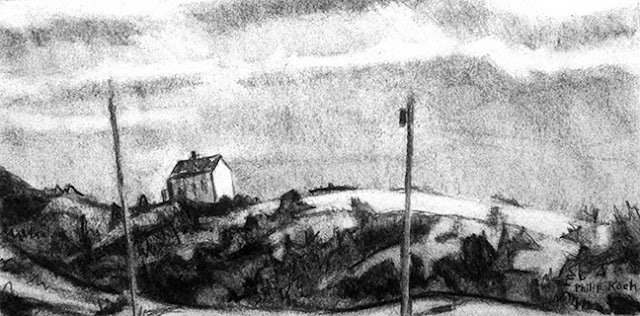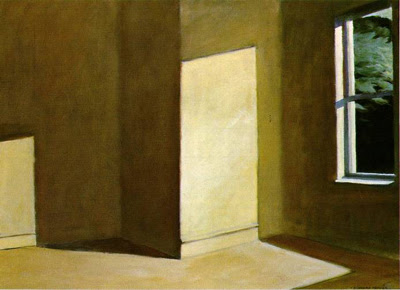Adirondacks & Plattsburgh State Art Museum, Part II

In my book nobody captures the spirit of being alive quite so well as Rockwell Kent in his work on paper. Above are two currently hanging in the Plattsburgh State Art Museum's Kent Gallery. At the top is wood engraving Godspeed of 1931 where an angel guides and protects a lonely mariner crossing the vast sea. Who wouldn't want such a gentle helping hand from the the heavens? Kent creates a beautiful contrast between the angel's angular arms and the open sweeping flow of her skirts. The figure's silhouette alone imbues the angel with life and personality.
Underneath it is Pinnacle, a lithograph from 1928 where a dark silhouetted man breaks up the empty white sky. I love the little white space squeezed between the figure's right forearm and his hips. The man and the boulder share a massive yet elegant solidity. He seems to become everyman taking in the whole world. (If you click on the photo you'll get a larger version of the prints that shows much of their elegant detail).
Here below I'm standing in front of a wall of prints Kent made to illustrate a new edition of Moby Dick. Such a display constitutes an embarrassment of riches to me. It demonstrates Kent's remarkable versatility with composition and story telling. I tried to pick out a favorite but after a few minutes had to give up as I liked so many.
Here below is a close up of one of the more gripping Moby Dick engravings. The whale has grabbed a rowboat of sailors and is plunging downward with it.
Nearby the Plattsburgh Museum has a preparatory drawing for this print hanging and it's instructive. Notice while the drawing shows us a lot about the whale, how Kent kept pushing to tell us more about where the action was happening. As he goes further into the design in the later print version, he designs the space of the surrounding dark water to make the action feel more real. There's an important lesson here for all artists in seeing how Kent gradually works his way in stages toward a final vision. When I was a young artist I had this idea that the great artists had their work leap out of their head and onto paper in one fell swoop. It was an idea that celebrated my youthful impatience. I now value slow steady work towards a final goal. It's people like Kent who showed me this secret.

And here is a lithograph Kent made protesting the Cold War era Smith Act that the US Congress passed to silence its critics. Kent himself was forced to testify in front of the notorious House Un-American Activities Committee and for a time was prevented from traveling abroad when the State Department revoked his passport.
And here's my final Kent, a lovely little oil from off the coast of Maine. Titled Gold Rock, Monhegan, it shows the artist's knack for conceiving of nature in terms of expressive silhouetted forms. Compare for example the lively dialogue he sets up between the pyramid-like foreground rock and the camel hump shaped cliff in the background. Great light here too.
Of course the real reason I was up in the Adirondacks was the landscape. Here's a photo taken half way up Whiteface Mountain showing the low clouds colliding with on of the mountain's shoulders.
Here I am a little farther up Whiteface Mt., with Lake Placid in the background. Notice my jacket is zipped up against the wind at the higher elevation. Here you can get a sense of the sharper silhouettes of the Adirondacks that I like so much for subject matter. One can see the clear shapes Kent so enjoyed in many of the mountains here- no wonder Kent settled nearby.
Here are two of the vine charcoal drawings I completed while in Lake Placid. Each is 8 x 12" and drawn looking south toward the High Peaks region. And my focus in each is the silhouettes of the mountains against the sky. The Adirondacks just call out for that. I'll be using these drawings to make new paintings back in my studio.
And here is my wife Alice. Normally she is a hardworking nurse and therapist in mental health at a downtown hospital in Baltimore. Extremely dedicated, she works like a fiend. Except on vacation when she turns into a happy mellow vegetable. Here she is walking around a beaver pond at the base of Whiteface Mountain. If you look closely, you can see the beavers' den near the far shore just to the left of Alice's head.











